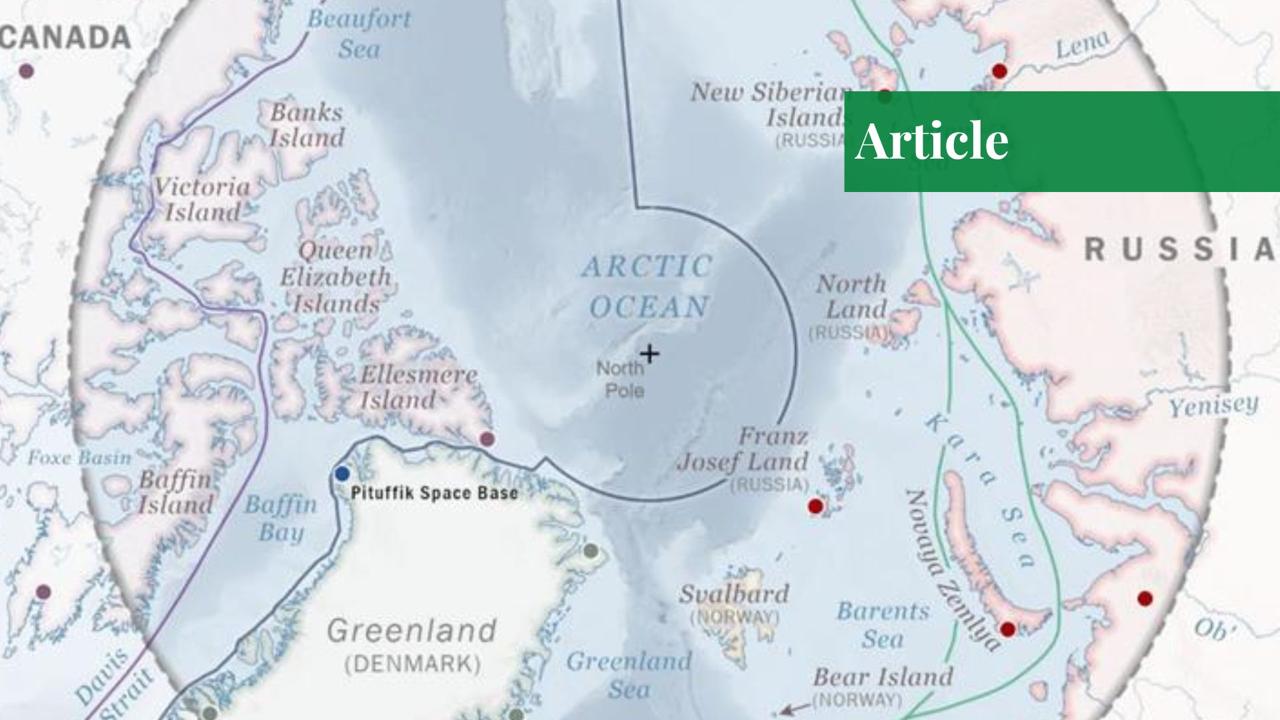Introduction
The Arctic region, associated with the North Pole, is becoming one of the most significant areas in terms of world politics, geo-economics, defense, and strategic interests. The region is dominated by 8 states, among which 6 are European nations. These include the US, Russia, Denmark, Canada, Sweden, Finland, Iceland, and Norway. It is bounded by the Barents Sea to the southwest, the Kara Sea to the south, the Laptev Sea to the southeast, and the Beaufort Sea to the north of the Arctic Ocean.
The region is approximately 14.5 million km2 and is Russian-centric. According to the United Nations Convention on the Law of the Sea (UNCLOS), approximately 53% of the region comes under Russian control. The rest is covered by the European (NATO) states, with the US having only 15% reach, thanks to its northern region of Alaska. Due to changing geopolitical dynamics, the Arctic region has now become a focal point of regional and global power projection and competition.
US Arctic Strategy 2024 – Key Excerpts
The US Department of Defense (DoD), in its Arctic Strategy of 2024, introduced a threefold strategy known as “Three Lines of Efforts” (3Es) to counter regional and global threats to the wider Arctic region and the securitization of the homeland. The 3-Es include Enhancement, Engagement, and Exercise under its monitor-and-response approach.
1. Enhancement
Under the Enhancement approach, a Joint Force of Action will be formed and reserved for the Arctic region. This force will work for the strengthening of the defense capabilities, including early warning systems, discrimination sensors, tracking sensors, and “Command, Control, Communications, Computers, Cyber, Intelligence, Surveillance, and Reconnaissance” (C5ISR). Either independently or with allies, the US will deliberately encircle the region to counter the ever-increasing Sino-Russian collaborations and ventures, a clear threat to the US monopoly.
2. Engagement
Under the umbrella of this approach, the US will work closely with not only its allies but also with the native and local authorities residing in the region. The US Arctic Policy of 2024 introduced the concept of ‘integrated deterrence,” which will enable the US and its allies to thrive together in political, economic, and military domains to counter all types of traditional and non-traditional threats emerging in the region.
The US-sponsored Joint Force of Action will engage with its European counterparts and Alaska Native tribes to ensure routine diplomatic dialogues and intergovernmental meetings. The introduction of the US Special Operations Forces (SOF) will definitely advance interoperability and experimentation in the region.
3. Exercise
This domain of the strategy deals with joint military operations and combat drills. The US bases in Alaska provide the first line of defense and deterrence against any regional or global threat. Other than this, the US maintains a wide web of military presence in the area of its NATO partners and European counterparts, which provides it leverage and much deeper access to the Arctic Ocean.
The other foremost reason for the militarization of the region by the US is to maintain and preserve the navigational rights and freedom of every state that borders the region under the rules and regulations prescribed by the UNCLOS. Just like the Indo-Pacific region, the US wants to create a free and open Arctic region and to counter Russian illegal territorial claims in the near future. As of February 2024, approximately 8000 soldiers in Alaska conducted a large-scale military exercise with partners including South Korea, Canada, Sweden, and Finland.
Hawkish Approach of President Trump
The 2024 election campaign of President Trump was much or less centered around the Arctic region. Under his Make America Great Again (MAGA) policy, Donald Trump explicitly announced that he would get back or seize the territory of Greenland and make Canada the 51st state of the US. As President Trump is a protectionist, he wants independent and direct control over the Arctic region, with less assistance from allies. That is the reason he wants to acquire Greenland and Canada.
Under the UNCLOS, the United States (Alaska) is only given 15% of direct control of the Arctic Ocean, while European states cover the rest of the region. Greenland covers approximately 12% of the ocean, and Canada controls 23%. If Greenland and Canada become part of America, then the US would have approximately 50% direct access to the ocean and would make it come to par with Russia. Thus, to counter the Sino-Russian advancements and to get control over the hidden indigenous resources, the Arctic region became strategically vital for the security of the homeland (US).
Arctic NATO
On 13 March 2025, during a press conference with NATO’s Secretary General Mark Rutte, President Trump mentioned, “The US has already ordered 48 icebreakers for this purpose. Russia has 40 icebreakers. We have to have protection. We have to make a deal on that. And Denmark is not able to do that. Denmark is very far away and really has nothing to do They landed there 200 years ago or something, and they say they have rights to it. I don’t know if that’s true; I don’t think it is, actually.”
This statement clearly depicts the ongoing security dilemma and great power rivalry in the region.
Regional and Global Implications
Russia has a reach of approximately 53% over the Arctic and covers the majority of the region’s resources. China has no physical borders with the Arctic, but being a very close ally of Russia, Sino-Russian collaborations and expeditions have increased over time. In 2018, China issued its white paper on Arctic policy, which stated that non-Arctic countries have rights in the region. Thus, Beijing is expanding and strengthening its foothold in the Arctic with the assistance of Moscow.
 You will find more infographics at Statista
You will find more infographics at Statista
Similarly, Russian civil and military expeditions and ventures have increased over the past few years. Russian icebreakers are continuously operating there in search of hidden resources and to get a clear, warm, and operational route for trade. PLA and Russian naval collaborations in the Arctic Ocean created a sense of insecurity in the US strategic thinking. This is the reason the US is now focusing on the Arctic region, which would have serious implications for China and Russia. Just like the Indo-Pacific, where China and the US are in direct conflict, the US will try its best to counter the Russian expansion over the Arctic.
Other than militarization, these three powers compete in Arctic research and literacy. Scientific research and expeditions are now becoming very common and are paving the way not only toward military conflicts but also economic ones. This great power rivalry in the Arctic will have a drastic impact beyond the region. This would not affect only the involved entities; rather, it would have a detrimental effect on the world’s climatic conditions, impacting developing and underdeveloped nations.
Conclusion
To conclude, whether it is the US, Russia, or China, they are all introducing their versions of policies and strategies regarding the future of the Arctic region. As the Arctic is melting and waterways are becoming apparent, the lust for power and resources is driving major players toward this region. International institutions could play a vital role in decreasing such heightened tensions. Major stakeholders and environmentalists could intervene to oversee compliance with climatic norms and values. The competition over the Arctic cannot be stopped, but it can be limited.
If you want to submit your articles and/or research papers, please visit the Submissions page.
To stay updated with the latest jobs, CSS news, internships, scholarships, and current affairs articles, join our Community Forum!
The views and opinions expressed in this article/paper are the author’s own and do not necessarily reflect the editorial position of Paradigm Shift.
He is pursuing a BS in International Relations programme from International Islamic University, Islamabad and has a keen interest in research works, policy analysis, defence and strategic studies and conflict resolution.



